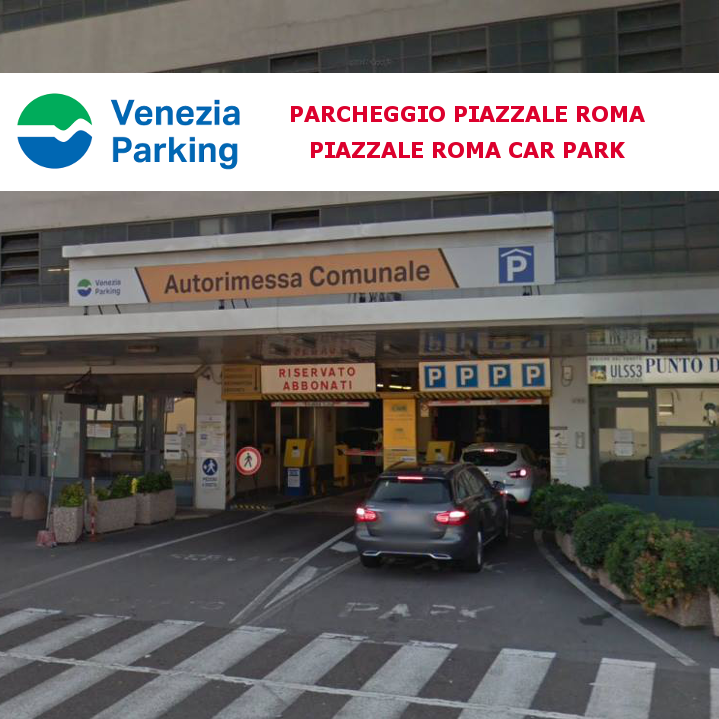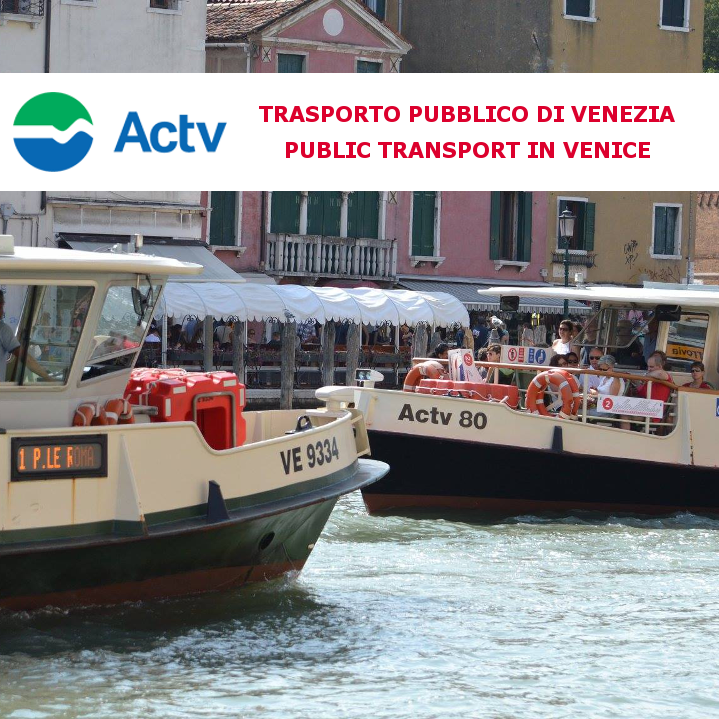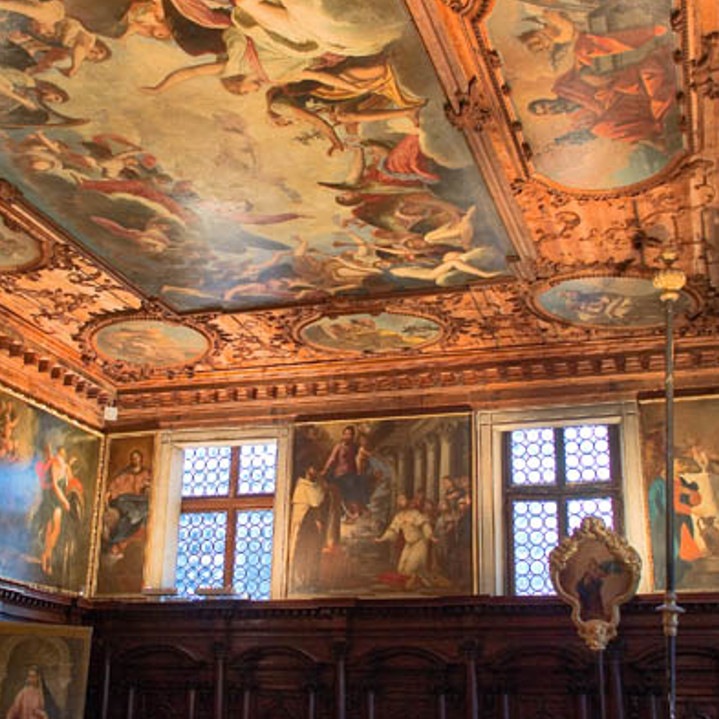You are here
Hidden gems of Venice
Hidden gems of Venice
This itinerary starts from Rialto and leads to the discovery of a specific area of the large Cannaregio district, including parts of it both well-known and little known to Venetians and tourists alike.
This route takes you to Campo dei Mori and from there to Strada Nova, to allow you either to walk back towards Rialto, or to go further to reach the railways station.
Following this itinerary moreover gives you the chance to discover the workshops of three artisans: Mario Berta Battiloro creates gold leaf the ancient way; Fallani Venezia makes hand-made silk prints; Momylia makes lume glass beads following the ancient tradition.
On your way you could find some traditional restaurants such as “osterie" and the "trattorie" serving genuine Venetian cuisine, such as appetizers made of various "cicchetti", pasta, “risi e bisi": that is risotto with peas, or even a fish risotto, as well as delicious spaghetti with clams. The spaghetti with squid ink, garlic, oil, cuttlefish, parsley and salt are also very tasty. As a second course you can taste the "sarde in saor or liver cooked the Venetian way, "baccalà mantecato”, or polenta served with the "schie", grey shrimps caught in the Venetian lagoon,all accompanied by a good glass of wine.
The Site “Venice and its Lagoon” has been inscribed on the World Heritage List since 1987 due to its Outstanding Universal Value, therefore it belongs to all of us: it is our common duty to respect it and preserve it so that it may be passed on to future generations.
The cultural heritage of the Site goes beyond the walls of palaces, churches, beyond islands and the lagoon, but is also memory, identity, community, all fundamental elements for the its vitality.
For this very reason the City Council launched the campaign #Enjoy/RespectVenezia in 2017, to raise awareness among the visitors and to encourage them to behave in a polite and correct manner during their stay, respecting the town and its inhabitants by keeping the right when walking on the streets, not stopping and sitting on the bridges, not feeding the pigeons and by respecting the place they are visiting keeping an appropriate behaviour.
- Duration: slightly over 3 hours
- Length: about 2 Km (1.5 mile)
- Mode of travel: the tour takes place entirely on foot
- Recommended period: this itinerary is feasible the whole year round, however it is best to carry it out in the morning in summer time, and in the late morning or early afternoon in winter time, due to the lack of shelter from adverse weather conditions. It might be necessary to alter slightly the route due to the weather
- Accessibility: this tour is accessible to all those who can move normally, even with a stroller or are visually impaired or blind. It is not completely accessible for those moving in a whellchair. In that case one can take the public transport ACTV from Rialto to Ca’ d’Oro to reach il Campo dei Gesuiti and be able to visit at least two of the craftsmen. It is advised to check each time the degree of disability, in order to adjust the tour to the individual needs. Il grado di accessibilità può essere accertato di volta in volta. For more information please visit the City of Venice website
- Departure: Campo San Bartolomeo
- Arrival: Strada Nova, next to the Cinema Italia - San Marcuola
-
Points of interest:1. Carlo Goldoni's statue and Fondaco dei Tedeschi
2. San Giovanni Crisostomo Church and SS. Apostoli Church
3. Scuola dei Sartori
4. Tiziano's House
5. Gesuiti Church
6. Oratorio dei Crociferi
7. Murano and San Michele islands
8. Calle Racchetta
9. Scuola Grande della Misericordia
10. Tintoretto's House
11. Campo dei Mori
12. Palazzo Loredan Gheltof - District: Cannaregio
- Interconnection with other itineraries: "Trade and power between Rialto and San Marco" and "Crossroads of the world: jews, moors, and christians"
Listen to the audio tour
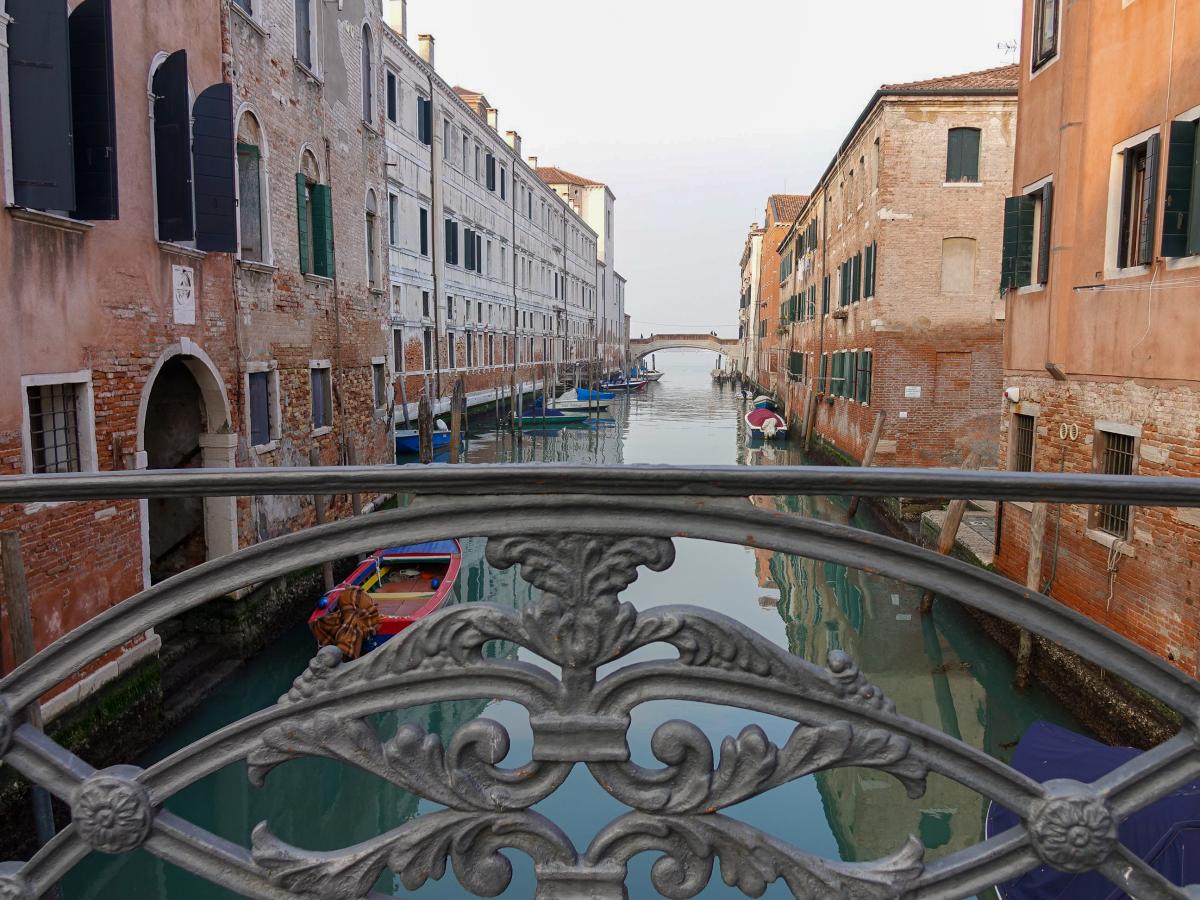
A view from Ponte Acquavita, Cannaregio
ph. Gabriele Vattolo - Comune di Venezia
Table of contents
- STAGE 6: Fondamenta Misericordia - Campiello dei Trevisani - Campo dei Muti – Tintoretto's House - Campo dei Mori - third craftsman Momylia, who creats lume glass beads (20 minutes / add 20 minutes for a tour of the workshop)
- STAGE 7: Campo dei Mori – Fondamenta Ormesini - Palazzo Loredan Gheltof - Rio Terà Farsetti - Strada Nova (20 minutes)
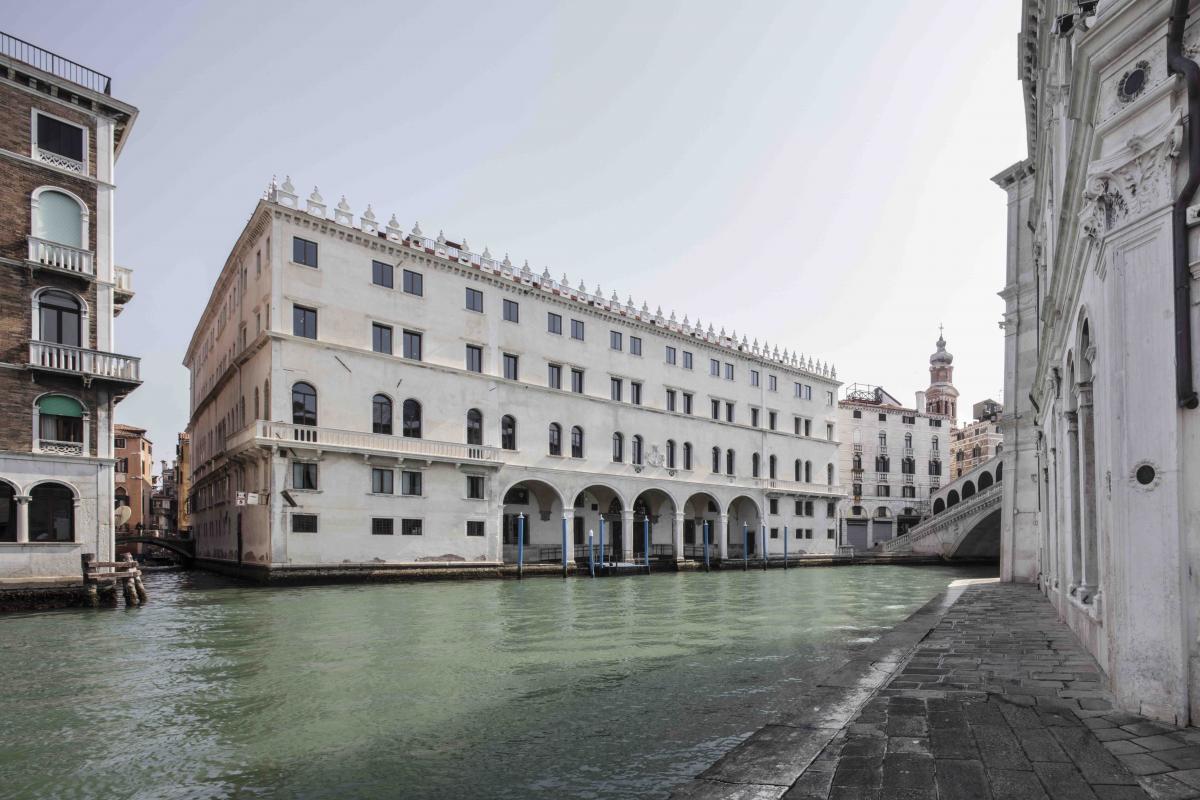
Fondaco dei Tedeschi, on the Grand Canal
ph. Giorgio Bombieri - Comune di Venezia
Starting point and Stage 1: From Campo San Bartolomeo to Campo Santi Apostoli
Campo San Bartolomeo, known locally as San Bortolo, is our starting point, which crosses over with the San Marco itinerary.
In the centre of the “campo”, that is square for the locals, stands a big bronze statue cast in 1883 representing Calro Goldoni, the father of Italian theatre. All around it Venetians and tourist crowd the area, night and day. After all, we are at the Rialto bridge!
Right behind the statue you see a narrow alleyway, where you find the only public facilities on this leg. If you face the monument you will see on the background a huge palace with a white plastered facade, nowadays a luxury department store, which still bears the name of the ancient dwelling place of the Central European merchants: The German Trading Centre or Fondaco dei Tedeschi.
From 1508 to 1797 it housed, among others, the Fugger family, the leading banking and merchant dynasty from Augsburg. Giorgione and Titian had painted famous frescoes on the facades, sadly only few fragments are now preserved in the Galleria Franchetti alla Ca’d’Oro.
Walking on alongside the Fondaco you cross the Ponte dell-Ogio (oil) and are now in Cannaregi. On your left there was the Persian Trading Centre, dating from the same time of the German one. The narrow alleyway leads you to S.Giovanni Crisostomo Church, dating from 1488. In it hangs one of the last works painted by Giovanni Bellini in 1513, while one of Sebastiano del Piombo’s masterpieces decorates the high altar. Moving on you reach the bridge “dei zogatoli”, (Venetian for toy) named after a toy shop, opend in 1866 and now closed.
Here comes Campiello Flaminio Corner, who was an important Venetian patrician and historian in the 1700s. Now the alleyway turns into a porch, in Venetian Sotoportego, leading to ponte Falier. Above it you can still see the palace, whose facade overlooks Campo SS.Apostoli, which is decorated by ancient windowsdating from the XII century. Here lived the ill-fated Doge Marin Faliero. The large square in front of the palace is dominated by the SS. Apostoli Church, rebuilt 1575 e famous because of the Cappella Corner, dating from an earlier church, and worth a visit because of G.B.Tiepolo-s , “La Comunione di S.Lucia”. The belltower was instead rebuilt in the 1700s.
On the laft hand side on the the square stands a two-storey elegant building, the Scuola dell’Angelo Custode (Guardian Angel), visible on the facade. Today this is the Lutheran Church, which houses a portrait of Martin Luther painted by Lukas Cranach.
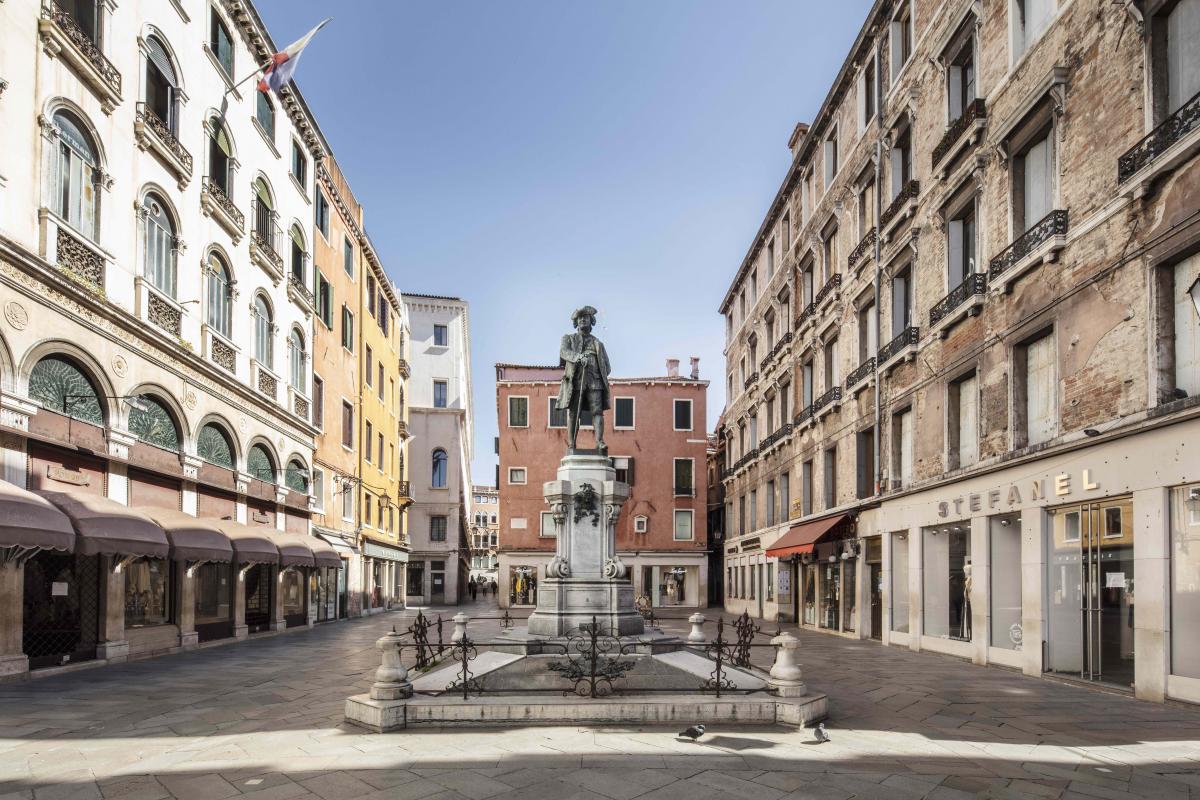
Campo San Bartolomeo
ph. Giorgio Bombieri - Comune di Venezia
Stage 2: From Rio terà dei Franceschi to the workshop Mario Berta Battiloro
Proceeding alongside the SS. Apostoli Church you then turn right onto Rio Terà dei Franceschi, another Venetian name meaning a filled-in canal, which is named after the burgess family which owned few buildings here.
Turn left to take a narrow alleyway leading to Rio Terà Barba Frutariol, another filled-in canal, where the boats coming from Murano, Burano e Torcello once moored. Here there is a public fountain, in case you felt thirsty.
“Frutariol” means greengrocer. Tradition says that here there was a greengrocer owned by a Mr. Barba. Hence the name. Leaving this street to your right you cometo the Ponte dei Sartori, that is “tailor”. The Guild of Tailors had nearby a hospice for “poveri sartori” (poor tailors) in 1511.
Looking to your left on the fondamenta you see a lovely bas relief representing the Virgin Mary and Child between the patron saints of the tailor, with a date and an inscription. On the right stands Palazzo Seriman, bought by the family in 1723, where today live i some nuns.
Take the wide street on your right, Calle Venier, which leads you on a straight line to the Ponte dell’Acquavita, named after a shop selling brandy, by crossing the bridge you find yourself on Campo del Tiziano, where Mario Berta Battiloro, the last of his kind, lives and works.
A “battiloro” iturns solid gold into very thin layers by hammering them. He is the last heir of this anciet craft. For booking and information call: 0039-0415222802 www.berta-battiloro.com e-mail: info@berta-battiloro.com
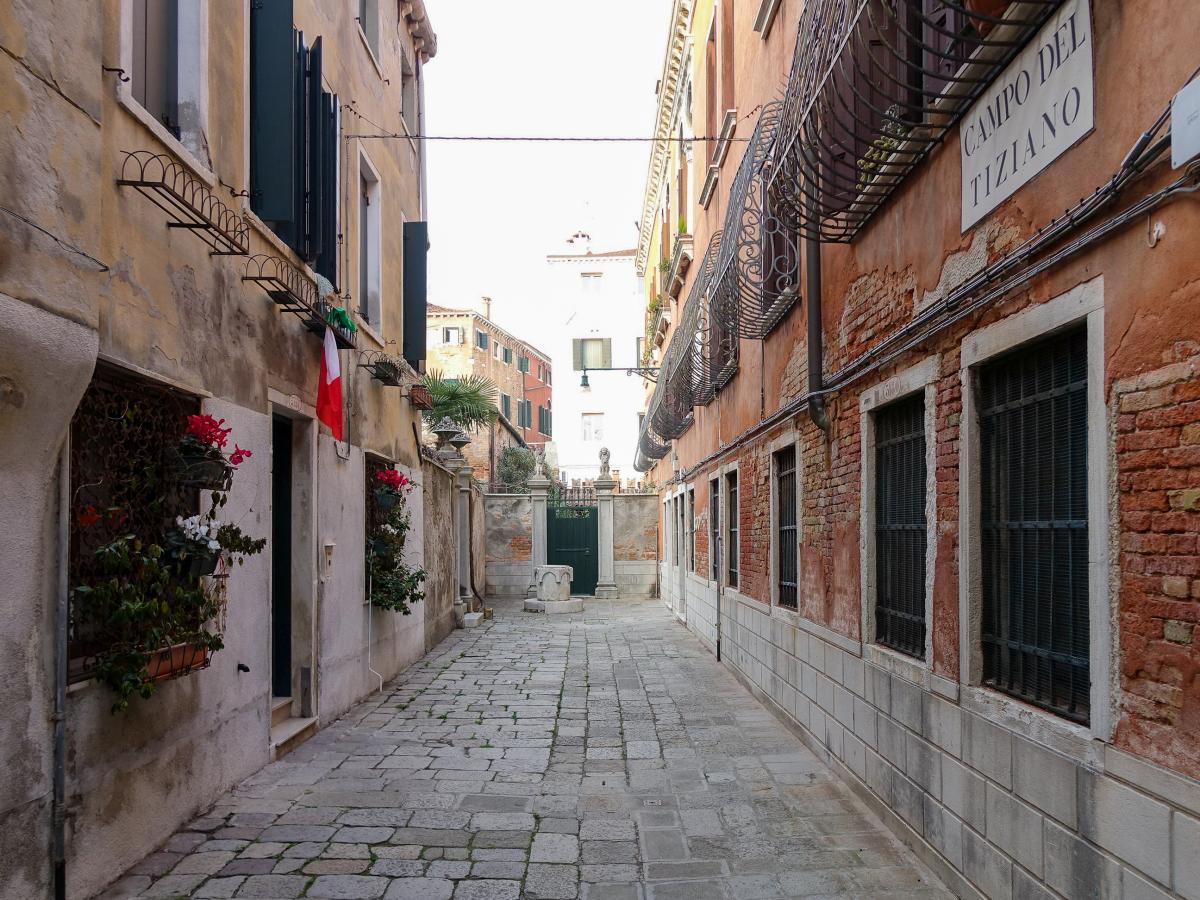
Campo del Tiziano
ph. Gabriele Vattolo - Comune di Venezia
Stage 3: From Tiziano's House to the Oratorio dei Crociferi
Before leaving the craftsman one has to mention that Mr.Berta lives and works in what was once part of Titian’s home and garden. The painter bought this house after his wife Celcilia's death in 1530. Legend has that Titian was homesick, therefore he bought a hose in this area, because he could see the Cadore mountains he came from. When he died in 1576 some sketches were found in his house, one of these is hanging now in the Doge’s Palace in the Sala delle Quattro Porte.
You now need to walk back along Calle Venier and to its end, where you turn right and cross the bridge taking you into a vast square Campo dei Gesuiti. On your left you see the long Fondamenta Zen, but you walk straight on towards the S. Maria Assunta Church called Chiesa dei Gesuiti, towering with its Baroque façade since 1723.
The walls indoor are lined with stone which looks like fabric, and a wonderful masterpiece by Titian, “Martirio di S.Lorenzo” shines in its uniqueness, as it is a “notturno”. The church is open for service, therefore opening times can vary, please contact 0039- 041 5231610.
Next to the church stands the former monastery, turned into army barracks after the Jesuites were expelled from Venice, and now it as serves a student accommodation for the University. Facing the monastery you see a modest building, which shows just a small bas relief, however it hides a jewel of the Venetian painting school of the 1500’s: Oratorio dei Crociferi.
This was one of the oldest hspices in Venice and was in use until few years ago. It has been restaured and opend to the public, which can enjoy the gorgeus paintings by Jacopo Palma il Giovane, who studied under Titian and Tintoretto.
Venice in Peril Fund (Inghilterra), Pro Venezia (Svezia), Stichting Nederlands Comité Venetie (Olanda), Friends of Venice (Dallas Texas) have played a major role in saving this monument. For information e booking:Tel. +39 0413096605 cultura@fondazioneveneziaservizi.it; www.fondazioneveneziaservizi.it.
Campo dei Crociferi
ph. Giorgio Bombieri - Comune di Venezia
Stage 4: From Fondamenta Nove to the workshop Fallani Venezia
Leaving the Oratorio to your left and the church on your right you just need to walk few steps to reach Fondamenta Nove, the last part of Venice to be built thanks to the reclaiming of a strip about 100 metres wide. In 1589 the work was over, however it will have to be repeated in 1766 after a gale, hence the name.
The view from here is breath-taking, especially on windy days, when you see the Dolomites, a view once common and beloved by Titian, who came from Pieve di Cadore, and lived in this area because of the view. What you see every day are the famous islands Murano and S. Michele, only few minutes away by public transport.
Murano is at the heart of blown glass industry, once a State secret, and still nowadays awe inspiring. In 1291 la Serenissima had all glass works moved to the lagoon from the town because of frequent fires. The island enjoyed privileges such as having its own city council, minting coins, and glass masters could marry patrician ladies; criminal reaching the island could not be arrested, hence the expression: Muranese Maganzese (traitor) All these measures ensured the glass masters would not leave taking their secrets with them, in that case they would be put to death. This art almost died out at the end of the Republic, to be revived in 1838, and now it is known and copied worldwide. Murano houses imortant works f art, such as the Chiesa di S.Pietro Martire dating from the 1400s, where a painting by Giovanni Bellini hangs, the wonderful rare absis and the mosaics in S.Donato, reminding of those in St.Mark’s Church.
Just before you reach Murano you pass by S. Michele.Here lived Fra’ Mauro, a Benedictine monk who drew the first globe by mid 1400s. The isand went to the Greyfriars and then, 1807, following Napoleon’s suppression of all place of worship. S. Michele becomes a Christian cemetery, outside the city walls because of public hygiene. In the orthodox precinct rest Igor Strawinski with his wife Vera, as well as Diaghilev and Josif Brodski. In the Protestant precinct rests Ezra Pound. S. Michele is still in use as Venice cemetery, therefore the tourist shuld bear that in mind when visiting the island.
Swalking along the fondamenta, where you find the bus stops for the lines connecting Venice with the islands, you see the straight line of the railways bridge and of the Ponte della Libertà, connecting Venice with the mainland. You now have reached the end, when you see a street on your left, Calle Santa Caterina, leading us to the second craftsman, Sig. Fallani, who makes silk-screen printing. His opens his workshop is open to visitors, please check his availability by calling: 0039- 335 585 1689 or write to info@fallanivenezia.com.
San Michele island
ph. Comune di Venezia
Stage 5: Madonna dell'Orto Church - Fondamenta Gasparo Contarini - Fondamenta della Misericordia
Leave Fallani's workshop, turn right and walk along Calle Longa S. Caterina, which takes you to Fondamenta S.Caterina. If you have a look at your left you can see the door to the former Chiesa di S.Caterina, now seat of the prestigious High School “Marco Foscarini”, which takes the area of the former monastery and of the church, partly destroyed by a fire in 1970, which caused the loss of many works of art.
Cross ponte Molin to find yourself on Calle Racchetta, which owes its name to badminton, which was been played here. This is a long and narrow street, which takes you to Sotoportego dei Preti, wher you turn right and end up on Fondamenta S.Felice, where the two itineraries overlap.
From this bridge you have the best possible view on the only bridge left in town without abutments, quite dangerous in adverse climate conditions. The other only bridge preserved in its original state is the much more famous Ponte del Diavolo in Torcello.
Turn right and cross another bridge leading to the Scuola Grande della Misericordia. Its construction was started in the early 1500s by Leopardi and completed by Jacopo Sansovino some 80 years later. Its sheer grand size proves the Scuola Grande’s importance and wealth, which was different from the guilds of arts and craft because its memeber were patricians and affluent merchants, who were helping the poor and the destitute as well as the ill people in town, thus also acquiring political influence and power.
The Scuole Grandi were founded around mid-1200s they grew and evolved together with Venice, were six. They were then suppressed by Napoleon in the early 1800s. In 1927 the Misericordia became the seat of the basketball team Reyer, but was closed down in 1991. However, in 2016 the Misericordia came back to life after a major restauration work and is now seat for art exhibitions.
The square facing the building has been used as a set for the films “Casanova” and “The Tourist”. After admiring la Misericordia, you can stroll along the Fondamenta della Misericordia, named after the Scuola passing by Palazzo da Lezze, a Baroque palace built after Longhena’s design.
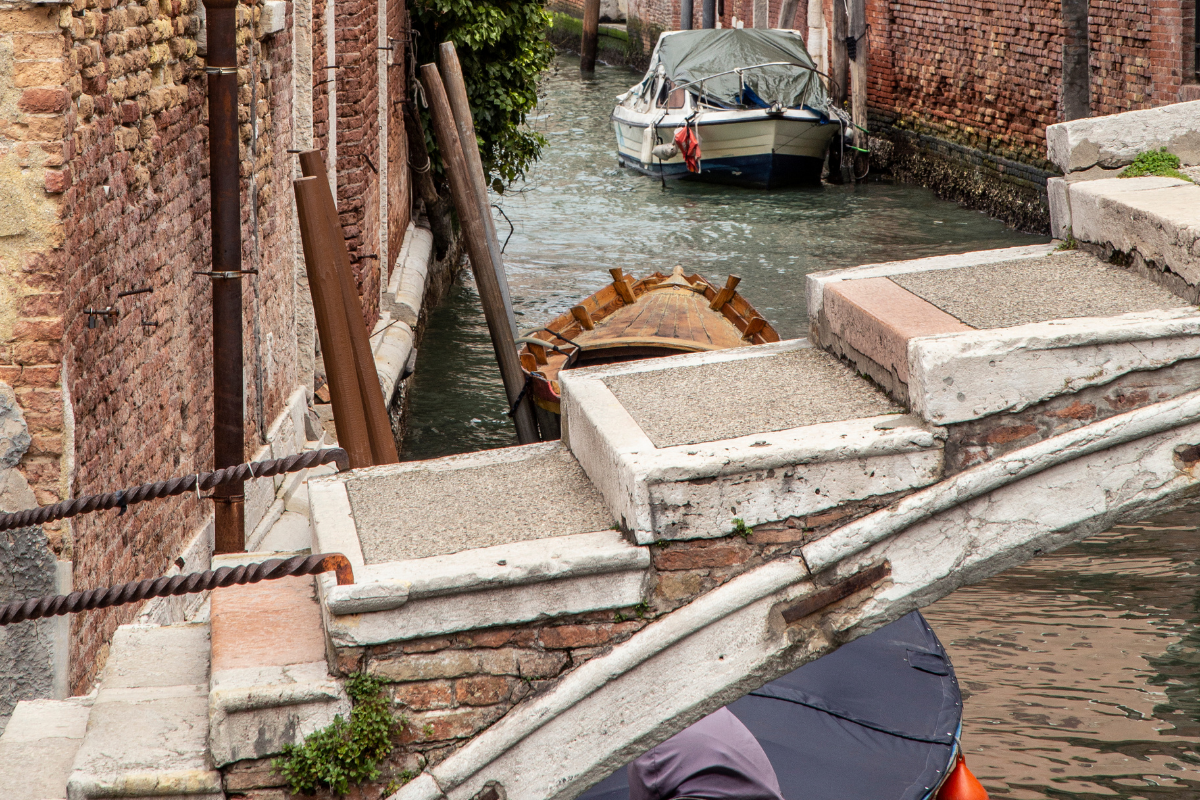
Ponte Chiodo
ph. Giorgio Bombieri - Comune di Venezia
Stage 6: From Campiello dei Trevisani to the workshop Momylia
Few steps after Palazzo da Lezze turn right into the Campiello dei Trevisani, where you can drink some fresh and cool water from the public fountain.
In former times this was a hospice for poor people coming from Treviso and the surrounding area.
You cross a bridge and turn left right away, you will see asmall squero,a Venetian word meaning shipyard, with a small garden on the front.Here live the “tre del ponte”, three of the bridge. These are three cats fed and looked after by the neighbourhood, in the best Venetian tradition.
Cross the bridge to come into Corte dei Muti. A “corte” in Venice is a square with just one street leading into it and only leading out, just like in a courtyard. This place is named after the Muti household, who was living here. Following the street you walk past Tintoretto’s House, He was the son of a cloth dyer, hence his name, and lived his whole life in the house which is a fine, small Venetian Gothic palace with traditional windows in the same style, rather tall and narrow.
On the facade notice a plaque and a portrait of the painter, together with a small stone image of Hercules. At present the house is the seat of the “Bottega del Tintoretto”, where a group oof artists holds various courses, including printing and etching.
Next to the entrance a man in Middle Eastern garb catches your eye, and right after that, in the corner, stands a statue with a large iron nose, Sig. Antonio Rioba, who voiced the mob’s cheecky and critical point of view. Like Pasquino did in Rome.
You reached Campo dei Mori, where other three statues were possibly part of the fence of a garden. Venetians even gave each one of them a name: Rioba, Santi e Alfani.
Few steps away from the statues here comes the third craftsman, MOMYLIA, who makes lume glass beads following the old tradition. For information and booking please contact: https://momyliaperlebijoux.com Tel: 041 2750658 E-mail: momylia@libero.it.
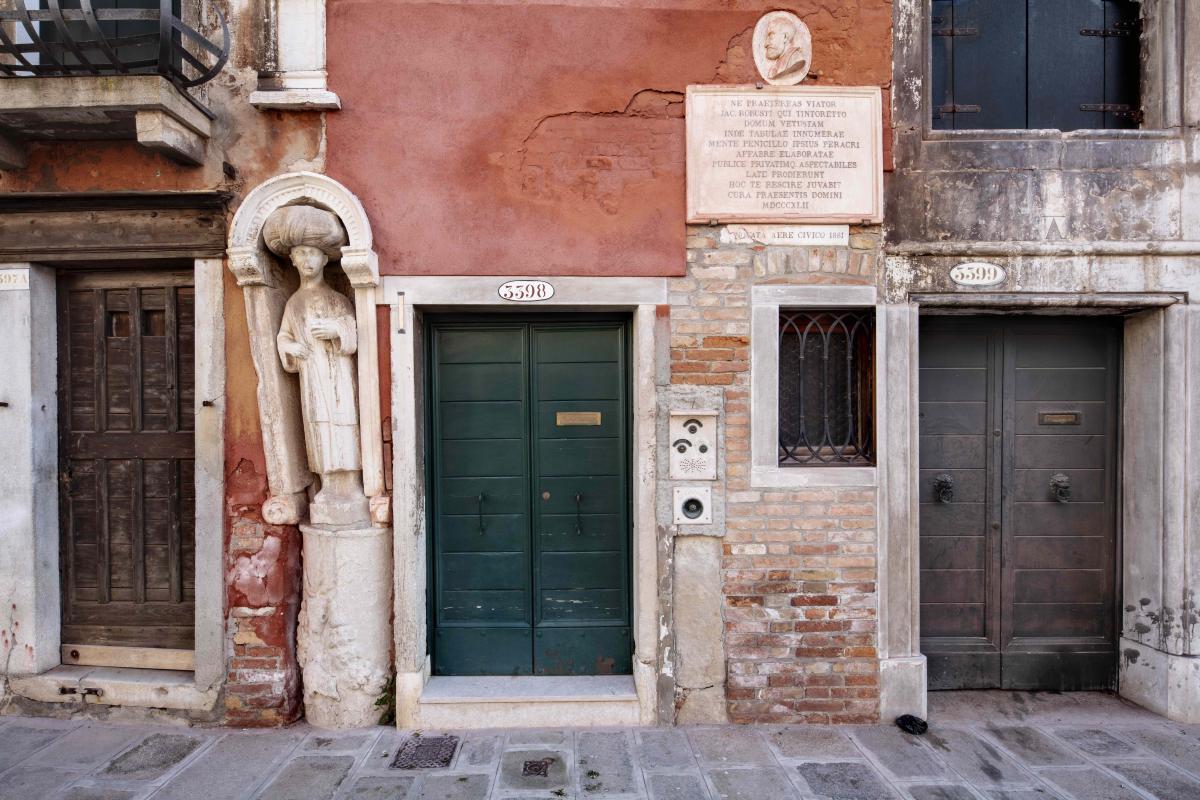
Casa di Jacopo Tintoretto
ph. Giorgio Bombieri - Comune di Venezia
Stage 7: From Campo dei Mori to Strada Nova
From Campo dei Mori turn right on to Fondamenta della Sensa, that is of the Ascension,which is one of the main festivals in town to these days. This long and straight street looks like a place out of this world, far away for the beaten track. It runs parallel to the much more trafficked and swinging Fondamenta della Misericordia, which then tales the name Ormesini, where young peole and students gather.
You can cross any of the bridges on your left, leading to Fondamenta degli Ormesini, where, according to tradition, lived some merchants from Hormuz, trading in silen clk cloth, called ormesini. Coming to the Ponte dell’Aseo you see the facade of one of the best examples of Venetian Gothic architecture, Palazzo Loredan Gheltof.
Cross Ponte Farsetti to your left to reach a rio terà, that is a filled-in canal. This name appears quite often in town, since quite a few canals were filled-in in the 1800s, however some have been dug again in recent times.
Rio Terà Farsetti leads to Strada Nova. From here you can choose to walk to the Rialto area by turning left along Via Vittorio Emanuele, known as Strada Nova, laid after 1866, when Venice became part of the Kingdom of Italy. Quite a few palaces and churches line this lively thoroughfare. If you turn right you reach the railways station crossing the Ponte delle Guglie, whereas you reach Palazzo Vendramin Calergi, where Richard Wagner lived and died, now the Casinò Municipale di Venezia. If you turn left, after the Ponte dell’Anconeta, you can reach the Ghetto from Rio Tera’ Farsetti, following the signs written in both English and Hebrew.
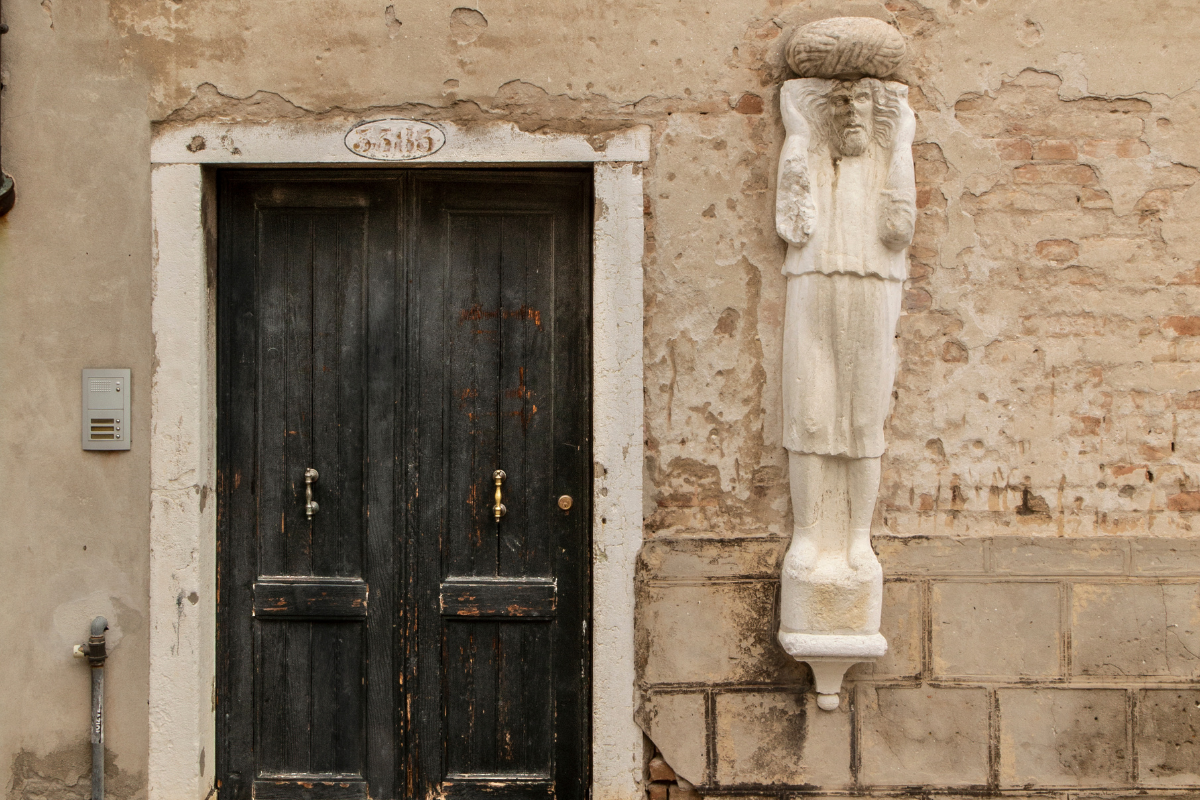
Campo dei Mori
ph. Giorgio Bombieri - Comune di Venezia
Useful information
- Squares and rest areas: There are no such areas in this itinerary, however there are the following squares: S. Bartolomeo, S.Giovanni Crisostomo, SS.Apostoli, Campo del Tiziano, Campo dei Gesuiti, Campo dei Mori, Campiello dei Trevisani.
- Pay Public toilet facilities: No public facilities available, except the one at the end of the walk on Campo S. Leonardo, a short distance from San Marcuola.
- Public drinking fountains: Campiello dei Trevisani, Campo dei Gesuiti



